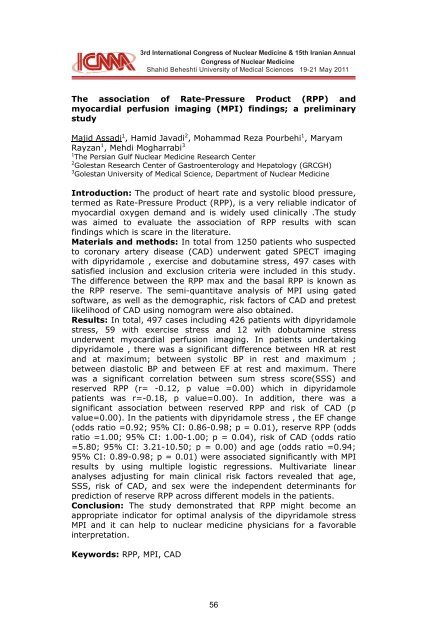Panel Disdussion
Panel Disdussion
Panel Disdussion
Create successful ePaper yourself
Turn your PDF publications into a flip-book with our unique Google optimized e-Paper software.
3rd International Congress 3rd International of Nuclear Congress Medicine of Nuclear & 15th Medicine Iranian Annual & 15th Iranian Congress Annual of<br />
Nuclear Congress Medicine of Nuclear Medicine<br />
Shahid Beheshti Shahid Beheshti University University of Medical Sciences of Medical 19-21 Sciences May 201119-21 May 2011<br />
The association of Rate-Pressure Product (RPP) and<br />
myocardial perfusion imaging (MPI) findings; a preliminary<br />
study<br />
Majid Assadi 1 , Hamid Javadi 2 , Mohammad Reza Pourbehi 1 , Maryam<br />
Rayzan 1 , Mehdi Mogharrabi 3<br />
1 The Persian Gulf Nuclear Medicine Research Center<br />
2 Golestan Research Center of Gastroenterology and Hepatology (GRCGH)<br />
3 Golestan University of Medical Science, Department of Nuclear Medicine<br />
Introduction: The product of heart rate and systolic blood pressure,<br />
termed as Rate-Pressure Product (RPP), is a very reliable indicator of<br />
myocardial oxygen demand and is widely used clinically .The study<br />
was aimed to evaluate the association of RPP results with scan<br />
findings which is scare in the literature.<br />
Materials and methods: In total from 1250 patients who suspected<br />
to coronary artery disease (CAD) underwent gated SPECT imaging<br />
with dipyridamole , exercise and dobutamine stress, 497 cases with<br />
satisfied inclusion and exclusion criteria were included in this study.<br />
The difference between the RPP max and the basal RPP is known as<br />
the RPP reserve. The semi-quantitave analysis of MPI using gated<br />
software, as well as the demographic, risk factors of CAD and pretest<br />
likelihood of CAD using nomogram were also obtained.<br />
Results: In total, 497 cases including 426 patients with dipyridamole<br />
stress, 59 with exercise stress and 12 with dobutamine stress<br />
underwent myocardial perfusion imaging. In patients undertaking<br />
dipyridamole , there was a significant difference between HR at rest<br />
and at maximum; between systolic BP in rest and maximum ;<br />
between diastolic BP and between EF at rest and maximum. There<br />
was a significant correlation between sum stress score(SSS) and<br />
reserved RPP (r= -0.12, p value =0.00) which in dipyridamole<br />
patients was r=-0.18, p value=0.00). In addition, there was a<br />
significant association between reserved RPP and risk of CAD (p<br />
value=0.00). In the patients with dipyridamole stress , the EF change<br />
(odds ratio =0.92; 95% CI: 0.86-0.98; p = 0.01), reserve RPP (odds<br />
ratio =1.00; 95% CI: 1.00-1.00; p = 0.04), risk of CAD (odds ratio<br />
=5.80; 95% CI: 3.21-10.50; p = 0.00) and age (odds ratio =0.94;<br />
95% CI: 0.89-0.98; p = 0.01) were associated significantly with MPI<br />
results by using multiple logistic regressions. Multivariate linear<br />
analyses adjusting for main clinical risk factors revealed that age,<br />
SSS, risk of CAD, and sex were the independent determinants for<br />
prediction of reserve RPP across different models in the patients.<br />
Conclusion: The study demonstrated that RPP might become an<br />
appropriate indicator for optimal analysis of the dipyridamole stress<br />
MPI and it can help to nuclear medicine physicians for a favorable<br />
interpretation.<br />
Keywords: RPP, MPI, CAD<br />
56
















